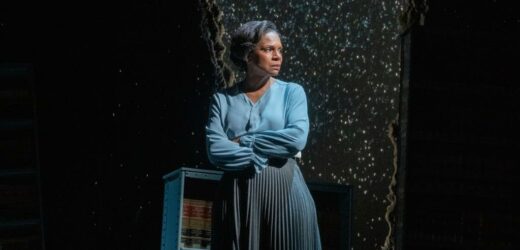It may be easy to take for granted that Audra McDonald, with six Tony Awards to her name, is capable of performances that creep delicately into your psyche and rattle around there as if clearing bats from its darkest recesses. A meticulous cartographer of the heart and mind, she charts human interiors that feel previously unknown, or, in the case of “Ohio State Murders,” which opened on Broadway Thursday night, unimaginable before she brings them to life.
That makes a kindred and celestial pairing of her and the playwright Adrienne Kennedy, debuting on Broadway at the age of 91 in the first production to christen the rededicated James Earl Jones Theatre. That Kennedy’s work is a heady collision of memory with trauma wrought by racist violence may partially explain the delay. There is heightened pretense, at least, that audiences today are more willing to look such ugliness in the face than they were in 1991, when the play premiered at Yale Repertory Theatre, or even in 2007, when it was presented off Broadway.
But it’s not just the subject of “Ohio State Murders,” directed here by Kenny Leon (“Topdog/Underdog”), that demands the sort of intellectual and emotional engagement that distinguishes theater from more passive mediums. Kennedy’s formal technique — the density of her lyricism, the selectiveness with which she chooses to disclose or withhold — is an engine of uncertainty, luring the audience over a cliff into a slippery sort of abyss. It’s an aesthetic reflection of her narrator’s fraught and unthinkable history.
Suzanne Alexander, a distinguished writer, has returned in the early 1990s to her alma mater, where she’s been asked to speak about the violent imagery in her work — “bloodied heads, severed limbs, dead father, dead Nazis” — whose origins trace back to heinous crimes she was subject to some 40 years before, when she was one of very few Black female students there. Her recollection is rich with particular details, like the layout of campus buildings and literary passages she remembers, read at length by a lecturer in his first year (Bryce Pinkham) from Thomas Hardy’s novel “Tess of the d’Urbervilles,” about a woman who is raped, punished for her impurity, and ultimately consumed by vengeance.
“Ohio State Murders” is not a mystery, nor is it structured around conventions of suspense — the crimes are right there in the title, and disclosures about its victims and perpetrator occur almost incidentally. Though these moments are not without the chill of revelation, Kennedy’s brilliance is in the intricacy of her character portrait, in articulating and illustrating the ways that pain and loss imprint on the mind and body. The trials Suzanne endured have shaped how she intersects with and expresses herself to the world beyond the isolation of suffering they caused. Hence, the bloodied head and severed limbs.
“Geography makes me anxious,” Suzanne says, as though mapping her relation to fixed landmarks only reinforces her own sense of displacement. McDonald is jittery, trembling at times, as she recounts Suzanne’s time at Ohio State, a fragility that vibrates beneath the composure of an artist who channels the grit of survival into her work. With drawn-out vowels and a heightened, almost mannered cadence, McDonald recounts how Suzanne used to wind her curlers so tight her scalp would bleed, and the paranoia she felt hearing white-girl laughter echoing down the halls of her dorm (the haunting sound design is by Justin Ellington). McDonald is both alert to the narrative’s every grim detail and yet somehow holds Suzanne at a subtle remove, a hypnotizing tug-of-war between vulnerability and verve.
McDonald is also performing a double role — playing both present-day and college-age Suzanne, where previous productions have cast two actors. It’s another means of showing how fresh decades-old wounds can feel, and their lifelong reverberations, while taking full advantage of McDonald’s versatility.
Leon’s production presents a bold, and unmistakable, visual representation of Kennedy’s argument for literature and imagination as both proof of human horror and an essential escape from it. The set design by Beowulf Boritt, a suspended cascade of bookshelves, sharply lit by Allen Lee Hughes, might be too on the nose were it not so startlingly beautiful.
By any obvious measure, Kennedy’s arrival on Broadway in her ninth decade is long overdue. Commercial theater has not generally been the most fertile ground for daring, confrontational work that spotlights the voices and experiences of the most marginalized. But when an exception takes root, with a team of artists as visionary as these, it’s certainly worth the wait.
Read More About:
Source: Read Full Article


